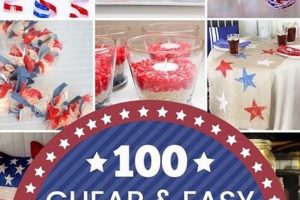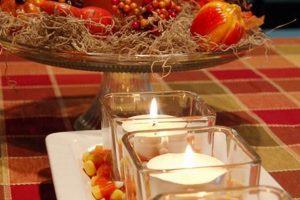Crafting personalized habitats for aquatic life through handmade elements offers a unique way to enhance the aesthetic appeal of an underwater environment. These creations, often born from readily available materials and individual ingenuity, transform a simple glass enclosure into a captivating display. Consider, for example, shaping inert clay into miniature rock formations or repurposing cleaned, aquarium-safe glass containers as hiding places for fish.
The practice of constructing customized underwater features provides several advantages. It allows for cost-effective customization, fostering creativity and enabling the creation of a biotope reflecting specific natural environments or personal artistic visions. Historically, aquarists have sought to replicate the natural habitats of their fish, often using locally sourced rocks and driftwood. This approach promotes the well-being of the inhabitants by offering secure environments and simulating their natural surroundings.
Therefore, a deeper exploration into safe materials, design considerations, and various crafting techniques will equip enthusiasts with the knowledge needed to successfully fabricate safe, visually appealing, and functional elements for their aquatic displays. Subsequent sections will delve into specific examples, addressing both the practical and aesthetic aspects of constructing these personalized aquarium features.
Essential Guidelines for Constructing Custom Aquatic Environments
Creating distinctive underwater sceneries requires careful planning and execution. The following recommendations emphasize safety and longevity when introducing handmade pieces to an aquarium.
Tip 1: Material Inertness is Paramount: Select only materials confirmed to be non-toxic and chemically inert when submerged. Aquarium-grade silicone, thoroughly cured, and certain types of plastic, labeled as safe for potable water, are often suitable. Avoid metals, painted items, and materials that may leach harmful substances.
Tip 2: Thorough Cleaning and Preparation: Prior to introduction, meticulously clean all crafted components. Scrubbing with a new, non-abrasive brush and rinsing under running water is essential. Boiling items safe for high temperatures can further reduce the risk of introducing contaminants.
Tip 3: Consider Biological Load: Design elements that minimize the accumulation of detritus. Complex structures with inaccessible crevices can become pockets of decaying organic matter, negatively impacting water quality. Opt for designs that allow for easy cleaning and water circulation.
Tip 4: Ensure Structural Integrity: Any assembled pieces should be robust enough to withstand the aquarium environment. Securely bond components with aquarium-safe adhesive. Weak or unstable structures can pose a hazard to fish and may disintegrate over time.
Tip 5: Research Compatibility with Inhabitants: Consider the specific needs of the aquarium’s inhabitants. Sharp edges or small openings can injure delicate fins or trap smaller fish. Ensure that all structures provide adequate space and do not impede natural behaviors.
Tip 6: Gradual Introduction and Monitoring: Introduce new elements incrementally, monitoring water parameters and fish behavior closely for any adverse reactions. Regular water testing is critical to detect potential imbalances caused by the introduction of new materials.
Tip 7: Mimic Natural Environments: Successful aquatic displays replicate natural habitats. Research the specific environments your fish originate from and incorporate elements that mimic those conditions in terms of substrate, rock formations, and plant life. The best of “diy fish tank decorations aquarium” result comes from this tip.
Implementing these measures will contribute to the creation of a healthy and visually appealing aquarium. Prioritizing safety and long-term stability ensures a thriving environment for aquatic life.
Adherence to these guidelines facilitates the responsible creation of personalized aquatic ecosystems. Further exploration into specific materials and design techniques will provide additional insights.
1. Material Safety
The practice of constructing personalized underwater features directly necessitates a meticulous consideration of material safety. The introduction of inappropriate materials into an enclosed aquatic ecosystem can precipitate a cascade of adverse effects, ranging from subtle shifts in water chemistry to acute toxicity events affecting the resident organisms. The cause-and-effect relationship is clear: substandard materials compromise water quality, which in turn jeopardizes the health and survival of the aquatic inhabitants.
As a fundamental component of customized underwater habitats, material safety cannot be overstated. Examples abound of well-intentioned projects gone awry due to oversight in this area. The use of improperly cured epoxy resins, for instance, can leach harmful chemicals into the water, leading to fish mortality. Similarly, untreated natural rocks can introduce undesirable minerals or alter pH levels, creating an inhospitable environment. The practical significance of understanding and adhering to material safety guidelines lies in the preservation of a healthy and balanced aquatic environment.
In summary, the selection of inert, non-toxic materials is paramount to the success and longevity of any created aquatic environment. Overlooking this critical aspect can have dire consequences for the ecosystem’s inhabitants. Recognizing the link between material composition and water quality empowers aquarists to create safe, sustainable, and aesthetically pleasing underwater displays.
2. Design Suitability
Design suitability represents a critical component in the successful implementation of “diy fish tank decorations aquarium.” The physical attributes of handmade elements directly influence the behavior and well-being of the aquatic inhabitants. A poorly designed structure, for example, may create dead zones with inadequate water circulation, leading to the accumulation of harmful bacteria and a subsequent decline in water quality. Conversely, a well-designed cave system can provide refuge for shy species, reducing stress and promoting natural behaviors. The causal relationship between design choices and the aquarium’s overall health is undeniable.
One practical example illustrating the importance of design suitability involves the construction of rock formations. Sharp edges or unstable arrangements can pose a significant risk of injury to fish. Similarly, small openings or crevices may trap smaller inhabitants, preventing them from accessing food or escaping from larger, more aggressive tank mates. Consideration must be given to the specific needs and behaviors of the aquarium’s occupants when formulating design plans. This includes providing adequate open swimming space, ensuring sufficient hiding places, and avoiding designs that could potentially disrupt the substrate or impede plant growth.
In summary, design suitability is not merely an aesthetic consideration but a fundamental aspect of maintaining a healthy and thriving aquatic ecosystem. Thoughtful planning, informed by an understanding of the needs of the aquarium’s inhabitants, is essential for creating a stable and enriching environment. Addressing potential design flaws proactively contributes to the long-term success of any “diy fish tank decorations aquarium” project.
3. Structural Integrity
Structural integrity is a non-negotiable attribute in the realm of “diy fish tank decorations aquarium.” The underwater environment subjects crafted elements to constant hydrostatic pressure and potential physical stress from inhabitants. Ensuring the robustness of these creations is paramount for the safety and stability of the entire aquatic ecosystem.
- Material Durability
The inherent durability of chosen materials dictates their resistance to degradation within the aquarium. Materials prone to softening, dissolving, or fracturing under prolonged submersion are unsuitable. Properly cured aquarium-grade silicone, inert rocks, and durable, non-toxic plastics are often preferred for their resilience and longevity in the aquatic environment.
- Joint Stability
For multi-component structures, the strength and stability of joints are critical. Inadequate bonding or fastening can lead to disintegration over time, posing a hazard to fish and potentially clouding the water with debris. Aquarium-safe adhesives specifically designed for underwater applications are essential for creating secure and lasting bonds between components.
- Weight Distribution and Support
The manner in which weight is distributed across the structure and the underlying substrate directly impacts its stability. Overly heavy or poorly balanced designs can collapse or shift, potentially damaging the aquarium glass or harming the inhabitants. Employing a wide base and ensuring even weight distribution are crucial considerations for maintaining structural integrity.
- Resistance to Biological Degradation
Organic matter, such as algae and bacteria, can gradually degrade certain materials over time. Selecting materials resistant to biological colonization and decay minimizes the risk of structural weakening. Regular maintenance and cleaning are also essential for preventing the build-up of organic matter and preserving the integrity of the crafted elements.
The interplay of these factors determines the long-term viability of handmade aquarium features. Neglecting structural integrity can result in the gradual deterioration of the crafted elements, potentially compromising the safety and health of the aquarium ecosystem. By prioritizing durable materials, robust joints, stable weight distribution, and resistance to biological degradation, aquarists can ensure the lasting beauty and functionality of their personalized underwater landscapes.
4. Water compatibility
Water compatibility constitutes a central tenet in the responsible implementation of “diy fish tank decorations aquarium.” The introduction of foreign materials into an enclosed aquatic environment invariably affects the delicate chemical balance of the water. Introducing incompatible elements can trigger adverse reactions, causing alterations in pH, hardness, or the release of harmful substances. These changes can, in turn, stress or even fatally harm the aquatic inhabitants. A practical example includes using unsealed concrete in an aquarium, which can leach lime and drastically raise the pH, creating an uninhabitable environment for many fish species. Water compatibility, therefore, dictates the health and stability of the entire ecosystem.
Specific applications demonstrate the practical considerations involved. The use of natural driftwood, for instance, requires careful preparation. Untreated driftwood can release tannins into the water, lowering the pH and tinting the water a brownish color. While some fish species thrive in such conditions, others are highly sensitive to changes in pH and require a more neutral environment. Thoroughly boiling or soaking driftwood before introduction can mitigate the release of tannins. Similarly, selecting inert rocks, such as slate or quartz, avoids the potential for mineral leaching. Prior research into the specific water parameter requirements of the intended aquatic inhabitants is therefore essential before embarking on any project.
In summary, ensuring water compatibility is not merely a precautionary measure but a fundamental requirement for the ethical and successful creation of personalized aquatic landscapes. By understanding the potential impacts of different materials on water chemistry and carefully considering the needs of the aquarium’s inhabitants, aquarists can minimize the risk of adverse effects and create a thriving and balanced ecosystem. Neglecting this aspect can have dire consequences, underscoring the importance of prioritizing water compatibility in all phases of the creative process.
5. Biological impact
The biological impact constitutes a significant consideration when crafting personalized underwater environments. Handmade elements introduced into an aquarium inevitably influence the biological processes occurring within the closed ecosystem. The design and material composition of these items can affect nutrient cycling, waste accumulation, and the overall health of the aquatic inhabitants.
- Surface Area and Biofilm Formation
The surface area of decorations directly impacts the colonization of beneficial bacteria. These bacteria play a crucial role in the nitrogen cycle, converting harmful ammonia and nitrites into less toxic nitrates. Conversely, excessive surface area can also promote the growth of undesirable algae and heterotrophic bacteria, potentially leading to oxygen depletion. The texture and porosity of materials influence the rate and type of biofilm formation, affecting water quality and the health of the aquarium’s inhabitants. A balance between providing ample surface area for beneficial bacteria and minimizing the potential for harmful growth is essential.
- Detritus Accumulation and Anaerobic Zones
Complex structures with small crevices and hard-to-reach areas can become traps for detritus (decaying organic matter). The accumulation of detritus promotes the development of anaerobic zones, where oxygen is depleted, and harmful bacteria thrive. These anaerobic zones can release toxic substances, such as hydrogen sulfide, into the water column, negatively impacting water quality and the health of the fish. Design choices that facilitate water circulation and prevent the build-up of detritus are crucial for maintaining a healthy biological balance.
- Impact on Aquatic Plants
The presence of decorations can influence the growth and health of aquatic plants. Decorations can provide anchoring points for plants, but they can also cast shadows, reducing the amount of light available for photosynthesis. The materials used in construction can also affect the availability of nutrients to plants. Certain materials may leach nutrients into the water, while others may absorb them, potentially limiting plant growth. Careful consideration of the lighting requirements and nutrient needs of aquatic plants is essential when designing and introducing decorations.
- Disruption of Natural Behaviors
Inappropriately designed decorations can disrupt the natural behaviors of fish and other aquatic organisms. Sharp edges, small openings, or unstable structures can pose a physical hazard to the inhabitants. Overcrowding or a lack of suitable hiding places can cause stress, leading to increased susceptibility to disease and aggression. The best DIY fish tank decorations aquarium should mimic the natural habitat for the fishes.
These considerations emphasize the importance of thoughtful design and material selection when creating personalized underwater environments. By understanding the potential biological impacts of handmade elements, aquarists can minimize the risks to their aquatic inhabitants and create thriving, balanced ecosystems. Integrating these principles into the construction process ensures a responsible and sustainable approach to the art of aquarium decoration.
6. Aesthetic Appeal
The aesthetic appeal represents a significant motivation for engaging in handmade aquatic environment construction. The visual harmony of an aquarium directly impacts the observer’s experience, transforming a functional enclosure into a captivating display. The successful integration of design elements creates a visually pleasing and engaging underwater world.
- Color Palette and Contrast
The selection and arrangement of colors contribute significantly to the aesthetic impact. Contrasting hues can highlight specific features or create a sense of depth. The judicious use of color can also mimic natural environments, enhancing the realism of the display. The colors of the substrates, rocks, and plant life should complement each other and the coloration of the aquatic inhabitants.
- Spatial Arrangement and Composition
The arrangement of elements within the aquarium influences the perceived balance and harmony of the scene. Applying principles of design, such as the rule of thirds, can create a more visually appealing composition. The placement of rocks, driftwood, and plants should create a sense of depth and perspective. Avoiding overcrowding and providing open swimming spaces enhances the overall aesthetic.
- Texture and Form
Varying the textures and forms of the decorations adds visual interest and complexity. Rough, jagged rocks contrast with smooth, rounded stones, creating a dynamic interplay of textures. The forms of the decorations can mimic natural shapes or represent abstract designs, depending on the desired aesthetic. The use of texture and form can also enhance the realism of the display, creating a more immersive experience.
- Lighting and Shadow
The strategic use of lighting can dramatically enhance the aesthetic appeal. Properly positioned lights can highlight specific features, create dramatic shadows, and simulate the natural lighting conditions of the aquatic environment. The intensity and color temperature of the lighting can also influence the perceived colors of the decorations and the aquatic inhabitants. Experimentation with different lighting techniques can transform a simple aquarium into a stunning visual display.
These aesthetic considerations are integral to the art of aquarium design. By carefully considering color, spatial arrangement, texture, and lighting, aquarists can create visually captivating and harmonious underwater landscapes. Aesthetic appeal is not merely a superficial concern, but a fundamental aspect of creating an engaging and enriching experience for both the observer and the aquatic inhabitants.
7. Aquatic life
The relationship between aquatic life and customized aquarium dcor is fundamentally intertwined, representing a critical determinant in the overall success of a closed aquatic ecosystem. The health, behavior, and longevity of the inhabitants are directly influenced by the design and composition of the underwater environment. Improper choices in dcor can induce stress, hinder natural behaviors, and even introduce toxic substances, leading to disease or mortality. For instance, sharp edges on handmade rock formations can injure delicate fins, while improperly sized caves may trap smaller fish, preventing access to food and increasing vulnerability to predation. Conversely, well-designed and carefully constructed elements provide shelter, reduce stress, and promote natural behaviors, such as breeding and foraging.
The selection of materials plays a pivotal role in safeguarding aquatic life. Inert materials, such as aquarium-safe silicone and specific types of plastic, are essential for preventing the release of harmful chemicals into the water. The presence of suitable hiding places and territorial boundaries is vital for maintaining social harmony within the aquarium. Furthermore, the design should facilitate adequate water circulation and prevent the accumulation of detritus, which can lead to anaerobic conditions and the release of toxic compounds. The creation of a balanced and stimulating environment, mirroring the natural habitat of the selected species, is paramount for their well-being.
In summation, the integration of aquatic life considerations is not merely an aesthetic embellishment but a fundamental requirement for responsible aquarium keeping. Careful planning and execution, informed by a thorough understanding of the needs and behaviors of the intended inhabitants, are essential for creating a sustainable and thriving aquatic ecosystem. By prioritizing the well-being of the aquatic life, aquarists can transform a simple glass enclosure into a vibrant and captivating display of natural beauty.
diy fish tank decorations aquarium
The following frequently asked questions address common concerns and misconceptions regarding the construction and implementation of handmade aquarium dcor. These responses aim to provide clear, concise information to ensure safe and aesthetically pleasing aquatic environments.
Question 1: Are all plastics safe for aquarium use?
No. Only plastics explicitly labeled as food-grade or safe for potable water should be considered for aquarium applications. Other plastics may leach harmful chemicals into the water, negatively impacting aquatic life.
Question 2: How does one ensure adhesive is safe for use in an aquarium?
Only aquarium-grade silicone adhesives are acceptable. These silicones are formulated to be non-toxic and chemically inert when fully cured. Standard household adhesives can leach harmful substances.
Question 3: Should rocks collected from natural environments be sterilized before aquarium use?
Yes. Thorough cleaning is essential to remove potential contaminants. Scrubbing with a brush and boiling the rocks can eliminate algae, parasites, and other undesirable organisms. This reduces the risk of introducing pathogens or unwanted hitchhikers into the aquarium.
Question 4: Is there a specific type of paint considered safe for painting aquarium decorations?
Painting aquarium dcor is generally discouraged. The long-term stability of paints in submerged environments is questionable, and the risk of leaching toxic substances is significant. If painting is unavoidable, ensure the paint is thoroughly sealed with an aquarium-safe sealant.
Question 5: How does one determine the appropriate size and number of decorations for an aquarium?
Consider the size and behavior of the aquarium’s inhabitants. Overcrowding can lead to stress and aggression. Provide ample open swimming space and hiding places appropriate for the species housed. Research the natural habitat of the fish to guide the selection and arrangement of dcor.
Question 6: How often should handmade aquarium decorations be cleaned?
Regular maintenance is essential to prevent the build-up of detritus and algae. Decorations should be periodically removed and cleaned with a soft brush and aquarium water. Avoid using harsh chemicals or detergents, as these can harm the aquarium’s ecosystem.
These FAQs serve as a foundation for understanding the essential considerations involved in creating custom aquatic environments. Adherence to these guidelines will contribute to a safe, healthy, and aesthetically pleasing aquarium.
The next section will delve into specific examples of handmade aquarium dcor, providing detailed instructions and practical tips.
Conclusion
The preceding exploration of “diy fish tank decorations aquarium” has highlighted the multi-faceted considerations inherent in crafting personalized underwater environments. From material safety and design suitability to structural integrity, water compatibility, biological impact, aesthetic appeal, and the well-being of aquatic life, a comprehensive understanding of these elements is essential for responsible aquarium keeping.
As enthusiasts embark on creating customized aquatic displays, a commitment to meticulous planning and adherence to established safety protocols remains paramount. The long-term success of these endeavors hinges on a dedication to the health and stability of the enclosed ecosystem. The meticulous crafting of aesthetically pleasing and functionally sound “diy fish tank decorations aquarium” provides enrichment not only to the observer but also, and more importantly, to the aquatic inhabitants within. Further research and continuous learning will only enhance the capabilities of aquarists to create thriving and captivating underwater worlds.







